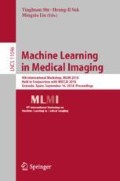Abstract
Deep learning has thoroughly changed the field of image analysis yielding impressive results whenever enough annotated data can be gathered. While partial annotation can be very fast, manual segmentation of 3D biological structures is tedious and error-prone. Additionally, high-level shape concepts such as topology or boundary smoothness are hard if not impossible to encode in Feedforward Neural Networks. Here we present a modular strategy for the accurate segmentation of neural cell bodies from light-sheet microscopy combining mixed-scale convolutional neural networks and topology-preserving geometric deformable models. We show that the network can be trained efficiently from simple cell centroid annotations, and that the final segmentation provides accurate cell detection and smooth segmentations that do not introduce further cell splitting or merging.
The research leading to these results has received funding from the European Research Council under the European Union’s Seventh Framework Programme (FP7/2007-2013)/ERC grant agreement no. 616905.
Access this chapter
Tax calculation will be finalised at checkout
Purchases are for personal use only
Notes
- 1.
- 2.
Note that fastER is limited to 2D images only.
- 3.
This would also speed up the entire pipeline as MGDM segmentation is the computationally more expensive part taking about 5 min for a \(256^3\) volume, while prediction with the MS-D net is about 10 times faster.
References
Bogovic, J.A., Prince, J.L., Bazin, P.L.: A multiple object geometric deformable model for image segmentation. Comput. Vis. Image Underst. 117(2), 145–157 (2013)
Brodmann, K.: Vergleichende Lokalisationslehre der Grosshirnrinde in ihren Prinzipien dargestellt auf Grund des Zellenbaues. Barth (1909)
Chung, K., Deisseroth, K.: CLARITY for mapping the nervous system. Nat. Methods 10(6), 508–513 (2013)
von Economo, C.F., Koskinas, G.N.: Die cytoarchitektonik der hirnrinde des erwachsenen menschen. J. Springer (1925)
Hilsenbeck, O., Schwarzfischer, M., Loeffler, D., Dimopoulos, S., Hastreiter, S., Marr, C., Theis, F.J., Schroeder, T.: fastER: a user-friendly tool for ultrafast and robust cell segmentation in large-scale microscopy. Bioinformatics (2017)
Hu, P., Shuai, B., Liu, J., Wang, G.: Deep level sets for salient object detection. In: 2017 IEEE Conference on Computer Vision and Pattern Recognition (CVPR), pp. 540–549. IEEE Computer Society (2017)
Huisken, J., Swoger, J., Del Bene, F., Wittbrodt, J., Stelzer, E.H.K.: Optical sectioning deep inside live embryos by selective plane illumination microscopy. Science 305(5686), 1007–1009 (2004)
Kandel, E.R., Schwartz, J.H., Jessell, T.M., Siegelbaum, S.A., Hudspeth, A.J.: Others: Principles of Neural Science, vol. 4. McGraw-hill, New York (2000)
LeCun, Y., Bengio, Y., Hinton, G.: Deep learning. Nature 521(7553), 436–444 (2015)
Morawski, M., et al.: Developing 3D microscopy with CLARITY on human brain tissue: towards a tool for informing and validating MRI-based histology. Neuroimage (2017)
Pelt, D.M., Sethian, J.A.: A mixed-scale dense convolutional neural network for image analysis. Proc. Natl. Acad. Sci. U.S.A. 115(2), 254–259 (2018)
Ronneberger, O., Fischer, P., Brox, T.: U-Net: convolutional networks for biomedical image segmentation. In: Navab, N., Hornegger, J., Wells, W.M., Frangi, A.F. (eds.) MICCAI 2015. LNCS, vol. 9351, pp. 234–241. Springer, Cham (2015). https://doi.org/10.1007/978-3-319-24574-4_28
Shen, D., Wu, G., Suk, H.I.: Deep learning in medical image analysis. Annu. Rev. Biomed. Eng. (2017)
Tang, M., Valipour, S., Zhang, Z., Cobzas, D., Jagersand, M.: A deep level set method for image segmentation. In: Cardoso, M.J., et al. (eds.) DLMIA/ML-CDS -2017. LNCS, vol. 10553, pp. 126–134. Springer, Cham (2017). https://doi.org/10.1007/978-3-319-67558-9_15
Vogt, C., Vogt, O.: Allgemeine ergebnisse unserer hirnforschung I-IV. J. Psychol. Neurol. (Lpz.) 25, Erg. heft 1, 279–462 (1919)
Xie, W., Noble, J.A., Zisserman, A.: Microscopy cell counting and detection with fully convolutional regression networks. Comput. Methods Biomech. Biomed. Eng. Imaging Vis. 1–10 (2016)
Zeiler, M.D.: Adadelta: an adaptive learning rate method. CoRR arXiv:abs/1212.5701 (2012)
Zilles, K., Schleicher, A., Palomero-Gallagher, N., Amunts, K.: Quantitative analysis of cyto-and receptor architecture of the human brain. Brain Mapping: The Methods (Second Edition), pp. 573–602. Elsevier, New York (2002)
Author information
Authors and Affiliations
Corresponding author
Editor information
Editors and Affiliations
Rights and permissions
Copyright information
© 2018 Springer Nature Switzerland AG
About this paper
Cite this paper
Thierbach, K. et al. (2018). Combining Deep Learning and Active Contours Opens The Way to Robust, Automated Analysis of Brain Cytoarchitectonics. In: Shi, Y., Suk, HI., Liu, M. (eds) Machine Learning in Medical Imaging. MLMI 2018. Lecture Notes in Computer Science(), vol 11046. Springer, Cham. https://doi.org/10.1007/978-3-030-00919-9_21
Download citation
DOI: https://doi.org/10.1007/978-3-030-00919-9_21
Published:
Publisher Name: Springer, Cham
Print ISBN: 978-3-030-00918-2
Online ISBN: 978-3-030-00919-9
eBook Packages: Computer ScienceComputer Science (R0)

